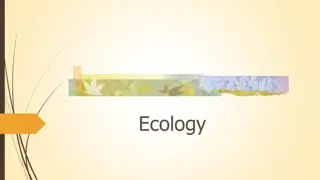Introduction to Ecology and Environment Studies
Ecology is the study of the relationship between organisms and their environment, while the environment refers to the surroundings that influence living organisms. The biosphere is divided into the atmosphere, lithosphere, and hydrosphere. Terms in ecology include species, populations, communities, and ecosystems, each with specific meanings. Understanding these levels of biological organization is crucial in environmental studies.
Uploaded on Sep 24, 2024 | 0 Views
Download Presentation

Please find below an Image/Link to download the presentation.
The content on the website is provided AS IS for your information and personal use only. It may not be sold, licensed, or shared on other websites without obtaining consent from the author.If you encounter any issues during the download, it is possible that the publisher has removed the file from their server.
You are allowed to download the files provided on this website for personal or commercial use, subject to the condition that they are used lawfully. All files are the property of their respective owners.
The content on the website is provided AS IS for your information and personal use only. It may not be sold, licensed, or shared on other websites without obtaining consent from the author.
E N D
Presentation Transcript
Abhipedia IAS Environment & Ecology INTRODUCTION TO ENVIRONMENT & ECOLOGY Pritam Sharma Abhimanu IAS ABHIMANU IAS : COMPLETE GENERAL STUDIES PRE CUM MAINS COURSE CALL 7347432666, MAIL AT INFO@ ABHIMANU.COM.. 1
Abhipedia IAS WHAT IS ECOLOGY? The word ecology s first proposed by a zoologist named Reiter in 1885, is derived from Greek words, Oikos meaning the dwelling place or home and logos meaning the discourse or study. Although, it was a German Biologist, named Ernst Haeckel who popularized this term and defined Ecology as the total relationship of an organism with both its organic and inorganic environment. The things of the world are classified into two major groups i.e. biotic component and abiotic component. The biotic component includes all types of living organisms, both plants and animals and the abiotic component includes the non-living materials (soil, water, air etc) and the forces of nature (light, gravity and molecular energy). ABHIMANU IAS : COMPLETE GENERAL STUDIES PRE CUM MAINS COURSE CALL 7347432666, MAIL AT INFO@ ABHIMANU.COM.. 2
Abhipedia IAS WHAT IS ENVIRONMENT? The word environment literally means surroundings and as such it refers to the aggregate of all those things and set of conditions, which directly or indirectly influence not only the life of organisms but also the communities at a particular place. In fact, th word environment is derived from a French word, environ meaning envelope or surroundings. The life-supporting environment of planet earth is called Biosphere. The biosphere is composed of three chief media-air, soil and water and on this basis biosphere has been divided into three-divisions: Atmosphere, Lithosphere and Hydrosphere respectively. Thus environment is a complex of factors acting, reaching and interacting with the organism complex. The totality of interactions that organisms have with each other as well as with their environment constitutes a system of nature called as Ecosystem. ABHIMANU IAS : COMPLETE GENERAL STUDIES PRE CUM MAINS COURSE CALL 7347432666, MAIL AT INFO@ ABHIMANU.COM.. 3
Abhipedia IAS TERMS IN ECOLOGY As we know that the living organisms can be studied at different levels of biological organization. In other words, we can say that the life can be organized into several different levels of function and complexity. These functional levels are: species, populations, communities, and ecosystems. It is significant to note that the terms, populations, communities and ecosystems have precise meanings in ecology such as: Species: Species are the different kinds of organisms found on the Earth. A more exact definition of species is a group of interbreeding organisms that do not ordinarily breed with members of other groups. If a species interbreeds freely with other species, it would no longer be a distinctive kind of organism ABHIMANU IAS : COMPLETE GENERAL STUDIES PRE CUM MAINS COURSE CALL 7347432666, MAIL AT INFO@ ABHIMANU.COM.. 4
Abhipedia IAS Populations: A population comprises all the individuals of a given species in a specific area or region at a certain time. Its significance is more than that of a number of individuals because not all individuals are identical. Populations contain genetic variation within themselves and between other populations. Communities: Community refers to all the populations in a specific area or region at a certain time. Its structure involves many types of interactions among species. Some of these involve the acquisition and use of food, space, or other environmental resources. Others involve nutrient cycling through all members of the community and mutual regulation of population sizes. ABHIMANU IAS : COMPLETE GENERAL STUDIES PRE CUM MAINS COURSE CALL 7347432666, MAIL AT INFO@ ABHIMANU.COM.. 5
Abhipedia IAS Ecosystems: Ecosystems are dynamic entities composed of the biological community and the abiotic environment. An ecosystem's abiotic and biotic composition and structure is determined by the state of a number of interrelated environmental factors. Changes in any of these factors (for example: nutrient availability, temperature, light intensity, grazing intensity, and species population density) will result in dynamic changes to the nature of these systems. For example, a fire in the temperate deciduous forest completely changes the structure of that system. In short, an ecosystem is a community of organisms and their physical environment interacting as an ecological unit. ABHIMANU IAS : COMPLETE GENERAL STUDIES PRE CUM MAINS COURSE CALL 7347432666, MAIL AT INFO@ ABHIMANU.COM.. 6
Abhipedia IAS Biome: It is a recognizable community unit formed as a result of interaction of regional climates with regional substrata. The members of a biome are the plants and animals inhabiting it. Thus , a biome is a large region characterized by certain forms of life. Most biomes are determined by their characteristic weather pattern or climate. Every biome is home to a number of ecosystems. For example: Freshwater biome includes, Ponds, lakes, rivers, etc.; tied closely to surrounding terrestrial biomes. It is an example of an aquatic biome. Similarly, Tundra biome is the northern most region adjoining the ice bound poles. It is devoid of trees except stunted shrubs in the southern part of tundra biome, ground flora includes lichen, mosses. The typical animals are reindeer, arctic fox, polar bear, snowy owl, lemming arctic hare. Reptiles/amphibians are almost absent. ABHIMANU IAS : COMPLETE GENERAL STUDIES PRE CUM MAINS COURSE CALL 7347432666, MAIL AT INFO@ ABHIMANU.COM.. 7
Abhipedia IAS Biosphere: The different ecosystems of the world constitute what we call as biosphere or ecosphere. This includes all living organisms and the physical environments with which they interact. Thus, the oceans, land surface and lower parts of the atmosphere all form part of the biosphere. ABHIMANU IAS : COMPLETE GENERAL STUDIES PRE CUM MAINS COURSE CALL 7347432666, MAIL AT INFO@ ABHIMANU.COM.. 8
Abhipedia IAS SUB-DIVISIONS OF ECOLOGY OR DIFFERENT APPROACHES TO ECOLOGICAL STUDIES. Ecology may be divided into two subdivisions broadly; autecology and synecology. What is Autecology? The word autecology is derived from a Greek word autos meaning self i.e. the study of single species or individual organism in relation to the environment or the habitat in which it grows at all stages of its life span. What is Synecology? The word synecology is derived from the Greek prefix Syn meaning together, so as to study the groups of organism in relation to their habitat and environment in which they grow. On this basis, the different approaches to ecological studies are: ABHIMANU IAS : COMPLETE GENERAL STUDIES PRE CUM MAINS COURSE CALL 7347432666, MAIL AT INFO@ ABHIMANU.COM.. 9
Abhipedia IAS (i) Habitat Ecology: Concerned with the nature of habitat. (ii) Ecosystem ecology: - involves the analysis of ecosystem from structural and functional point of view. (iii) Population ecology-concerned with the study of inter relationship of different groups of organisms. (iv) Paleoecology-concerned with the organisms and geological environments of the past. (v) different ecosystems. Production ecology-involves the study of gross and net production of ABHIMANU IAS : COMPLETE GENERAL STUDIES PRE CUM MAINS COURSE CALL 7347432666, MAIL AT INFO@ ABHIMANU.COM.. 10 (
Abhipedia IAS (vi) Gene ecology-concerned with the genetic constitution of species or population with respect to its environment. (vii) Conservation ecology:-includes the proper management of natural resources. viii) Radiation ecology: involves the study of radioactive substances, radiation and the environment. (ix) Human ecology: concerned with man in relation to his environment (x) Integrated ecology: concerned with the energy conservation and flow in the organisms within an ecosystem. ABHIMANU IAS : COMPLETE GENERAL STUDIES PRE CUM MAINS COURSE CALL 7347432666, MAIL AT INFO@ ABHIMANU.COM.. 11
Abhipedia IAS DEGRADATION OF ENVIRONMENT & ECOLOGY- A MAJOR CONCERN. Humans depend on environment for survival as it gives us oxygen to breathe, food to eat and water to drink. We also get fibre, medicines, fuel etc. from the environment. The rapid growth of human population and rapid industrialization has lead to the environmental degradation in two ways: (i) depletion of natural resources (ii) pollution of the environment (air, water and soil). Natural resources have been depleted through deforestation, excessive use of fossil fuels; mining etc. Whereas, air/water has been polluted by toxic gases emitting from motor vehicles, toxic wastes discharged into water bodies.
Abhipedia IAS Thank You ABHIMANU IAS : COMPLETE GENERAL STUDIES PRE CUM MAINS COURSE CALL 7347432666, MAIL AT INFO@ ABHIMANU.COM.. 13























